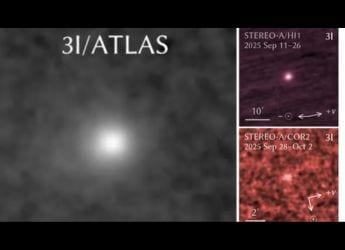- Home
- Science
- Science News
- Mystery Deepens as Interstellar Comet 3I/ATLAS Brightens Unexpectedly Near the Sun
Mystery Deepens as Interstellar Comet 3I/ATLAS Brightens Unexpectedly Near the Sun
Interstellar comet 3I/ATLAS, the third known visitor from another star system, astonished astronomers by brightening far faster than predicted during its close solar approach on Oct. 29, 2025.

Photo Credit: Q. Zheng, K. Battams, 2025
The 3I/Atlas comet brightening by an unexpected about as it approaches the sun.
Interstellar Comet 3I/ATLAS, discovered in July 2025, is only the third known visitor from another star system (after ʻOumuamua and 2I/Borisov). It passed its closest approach to the Sun (perihelion) on Oct. 29, 2025. At perihelion, astronomers expected a typical increase in brightness as solar heat vaporised its ices, but 3I/ATLAS instead brightened far faster than predicted. Scientists at Lowell Observatory and the U.S. Naval Research Laboratory note that this rapid brightening “remains unclear”.
Observations at Perihelion
As per a preprint report, Qicheng Zhang (Lowell Observatory) and Karl Battams (Naval Research Lab) confirm that 3I/ATLAS's brightening “far exceeds” the rate seen in typical long-period comets and say its cause is still “unclear”.
NASA's solar observatories (the twin STEREO probes and ESA's SOHO) and NOAA's GOES-19 satellite tracked 3I/ATLAS as it swooped around the Sun. These spacecraft recorded a sudden surge in the comet's brightness as it neared the Sun. Unusually, the comet's coma appeared “distinctly bluer than the Sun,” indicating that gas emissions (not just reflected dust) were contributing strongly to its glow. Mark Thompson (Universe Today) notes this colour shift suggests emissions from molecules like cyanogen and ammonia in the outgassing material.
Possible Causes and Future Observations
Zhang and Battams suggest several possible explanations. For example, the comet's extremely high speed might heat it differently than normal comets, and its internal composition could differ because it formed around another star. They also note that around 3 astronomical units from the Sun, 3I/ATLAS was shedding mostly carbon dioxide ice, which may have kept its nucleus unusually cool and delayed the normal water-ice sublimation.
Get your daily dose of tech news, reviews, and insights, in under 80 characters on Gadgets 360 Turbo. Connect with fellow tech lovers on our Forum. Follow us on X, Facebook, WhatsApp, Threads and Google News for instant updates. Catch all the action on our YouTube channel.
Related Stories
- Samsung Galaxy Unpacked 2025
- ChatGPT
- Redmi Note 14 Pro+
- iPhone 16
- Apple Vision Pro
- Oneplus 12
- OnePlus Nord CE 3 Lite 5G
- iPhone 13
- Xiaomi 14 Pro
- Oppo Find N3
- Tecno Spark Go (2023)
- Realme V30
- Best Phones Under 25000
- Samsung Galaxy S24 Series
- Cryptocurrency
- iQoo 12
- Samsung Galaxy S24 Ultra
- Giottus
- Samsung Galaxy Z Flip 5
- Apple 'Scary Fast'
- Housefull 5
- GoPro Hero 12 Black Review
- Invincible Season 2
- JioGlass
- HD Ready TV
- Laptop Under 50000
- Smartwatch Under 10000
- Latest Mobile Phones
- Compare Phones
- Huawei Mate 70 Air
- Moto G57
- Moto G57 Power
- Motorola Edge 70
- Moto G Play (2026)
- Moto G (2026)
- Realme C85 Pro 4G
- Realme C85 5G
- MacBook Pro 14-inch (M5, 2025)
- Asus Vivobook S16 (S3607QA)
- iQOO Pad 5e
- OPPO Pad 5
- Garmin Venu X1
- Redmi Watch 6
- TCL 55 Inch QD-Mini LED Ultra HD (4K) Smart TV (55Q6C)
- TCL 55 Inch QD-Mini LED Ultra HD (4K) Smart TV (55C6K)
- Asus ROG Ally
- Nintendo Switch Lite
- Haier 1.6 Ton 5 Star Inverter Split AC (HSU19G-MZAID5BN-INV)
- Haier 1.6 Ton 5 Star Inverter Split AC (HSU19G-MZAIM5BN-INV)

















